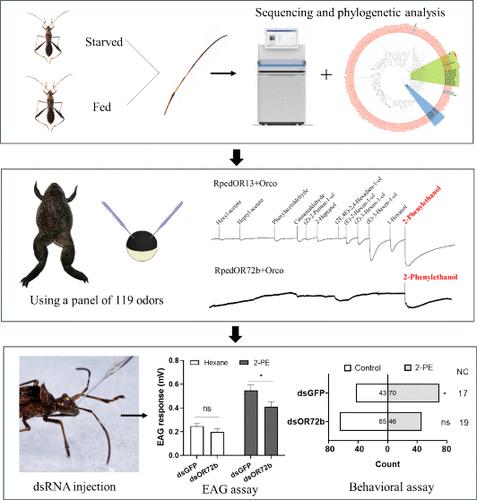IF 5.7
1区 农林科学
Q1 AGRICULTURE, MULTIDISCIPLINARY
引用次数: 0
摘要
豆虫 Riptortus pedestris 是一种主要的大豆害虫,也是造成留绿症状的原因之一。然而,其嗅觉介导的寻找宿主行为的分子机制仍不清楚。在这项研究中,我们比较了饥饿和非饥饿成虫的触角转录组,发现了四个不同表达的气味受体(OR)基因。其中,RpedOR13在爪蟾卵母细胞实验中对宿主挥发性物质2-苯乙醇(2-PE)表现出强烈的反应,而电触觉和行为测试证实2-PE是一种有效的吸引物。接下来,系统进化分析发现 RpedOR72b 是 RpedOR13 的旁系亲属,随后的爪蟾卵母细胞实验证实了它对 2-PE 的特异性反应。此外,RNA 干扰实验强调了 RpedOR72b 在检测 2-PE 中的关键作用。总之,这些发现为我们提供了关于 R. pedestris 寻求宿主行为的分子机制的新见解,并突出了反向化学生态学在基于 OR 的生物活性化合物筛选中的成功应用。本文章由计算机程序翻译,如有差异,请以英文原文为准。

Identification of a Soybean Volatile Attractive for Riptortus pedestris Using Reverse Chemical Ecology Approach
The bean bug Riptortus pedestris is a major soybean pest and a cause of the stay-green symptoms. However, the molecular mechanisms underlying its olfaction-mediated host-seeking behavior remain unclear. In this study, we compared the antennae transcriptomes of starved and nonstarved adult R. pedestris, identifying four differentially expressed odorant receptor (OR) genes. Among these, RpedOR13 showed a strong response to the host volatile 2-phenylethanol (2-PE) in Xenopus oocyte assays, while electroantennography and behavioral tests confirmed 2-PE as an effective attractant. Next, phylogenetic analysis identified RpedOR72b as a paralog of RpedOR13, with subsequent Xenopus oocyte assays confirming its specific response to 2-PE. Additionally, RNA interference experiments highlighted the crucial role of RpedOR72b in detecting 2-PE. Taken together, these findings provide new insights into the molecular mechanisms of host-seeking behavior in R. pedestris and highlight the successful application of reverse chemical ecology in OR-based screening of bioactive compounds.
求助全文
通过发布文献求助,成功后即可免费获取论文全文。
去求助
来源期刊
CiteScore
9.90
自引率
8.20%
发文量
1375
审稿时长
2.3 months
期刊介绍:
The Journal of Agricultural and Food Chemistry publishes high-quality, cutting edge original research representing complete studies and research advances dealing with the chemistry and biochemistry of agriculture and food. The Journal also encourages papers with chemistry and/or biochemistry as a major component combined with biological/sensory/nutritional/toxicological evaluation related to agriculture and/or food.

 求助内容:
求助内容: 应助结果提醒方式:
应助结果提醒方式:


